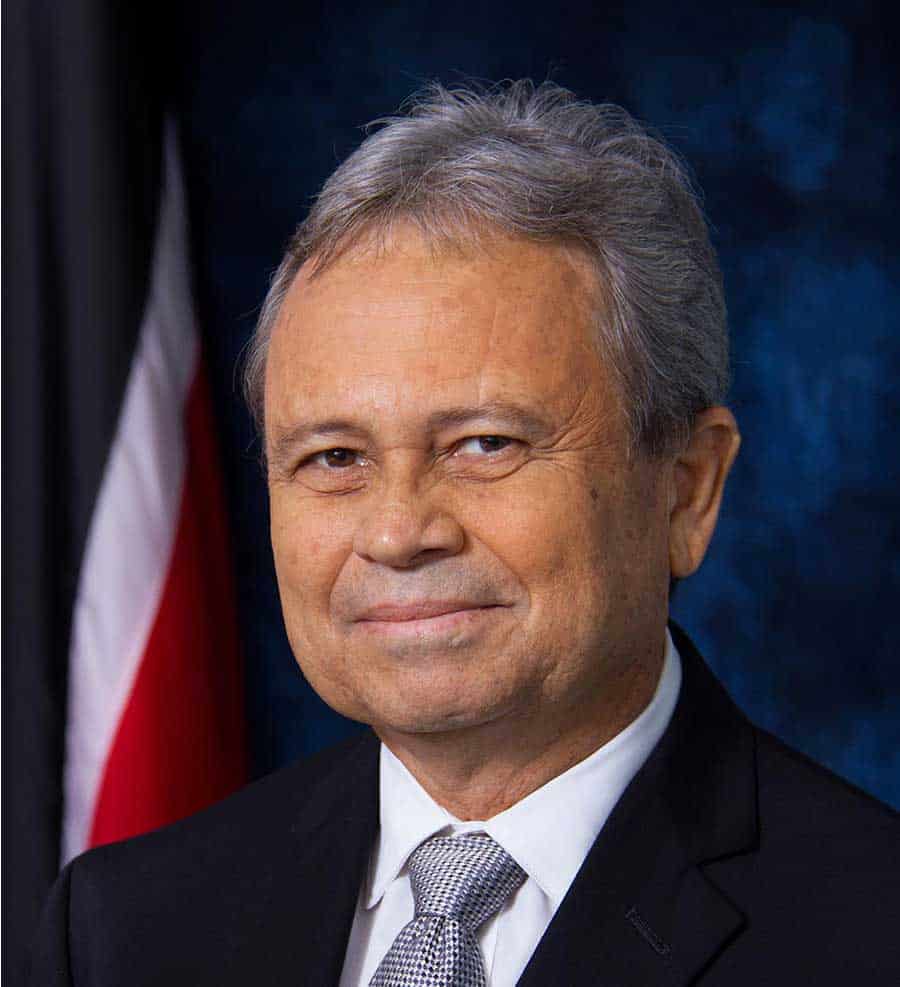
Above: Colm Imbert, Minister of Finance.
BitDepth#1218 for October 10, 2019
It’s not unusual for items in a national budget to be carried over from one year to the next. There are planning, infrastructure and bureaucratic requirements that provide the plinth on which the constructs of governance are built.
When they are ignored or bypassed in the interests of political expedience, you get eTeck’s Tamana InTech Park, a project that remains largely on hold by its budgetary allocation.
An electronic surveillance project at the park inched forward, with another $200,000 spent on a project budgeted at $2.8 million in 2018. A total of $2.2 million needs to be spent to complete the security measures.
Perhaps that’s because the government found a new technology windmill to raise its lance toward, racing madly toward construction of a new 133-acre technology park at Phoenix Park financed by the Chinese Belt and Road Initiative.
The 2019 budget promised that ten Chinese technology firms have expressed interest in setting up shop at the proposed Park31. There has been no word of those investors in the 2020 budget, though InvesTT is courting tenants for the project.
At the Cabinet level of governance consideration, technology is still viewed as a support tool, not an enabling one.
At least this way patrons of the watertaxi service will have a chance to wave goodbye to their money, an opportunity that’s largely been withheld from the population at large on the Tamana project, nestled comfortably away where it is in Wallerfield.
Budgets are a powerful tool in influencing the behaviour of a country.
To that end, it’s admirable that Minister of Finance, Colm Imbert, announced on Monday that the government would offer a tax credit of 100 per cent on solar heating equipment and the removal of taxes and duties on LED bulbs and “appurtenances.”
That’s excellent news, though it comes at the end of my five year phased removal of CFL bulbs, which replaced incandescents a decade ago.
As far as technology goes, the budget continues to quite determinedly march at its own implementation pace and the government’s enthusiasm about its projects suggests that they don’t realise how completely they have been lapped by every other nation of similar size and capacity claiming to be participating in the technology adoption race.
A year after announcing a multi-million dollar upgrade for the police service and suffering the humiliations of having the Police Commissioner approaching his own Mr Bumble at the Finance Ministry to ask politely for more, the project is said to be continuing.
The government has, however, promised to take a tablet to ease the country’s crime pains, promising to deploy 200 of them for mobile identification use at roadblocks.
The government has, however, promised to take a tablet to ease the country’s crime pains, promising to deploy 200 of them for mobile identification use at roadblocks.
Will they be connected to a central database? Probably not.
Part of the reason for these puzzling decisions might be found in the way ICT is organised for budgetary consideration.
The government organises its spending along five pillars of consideration and ICT spending is firmly placed in ‘Improving Productivity through Quality Infrastructure,’ not, as one might expect, under ‘Building Globally Competitive Businesses.’
At the Cabinet level of governance consideration, technology is still viewed as a support tool, not an enabling one.
It might be argued that as part of the infrastructure pillar, ICT gets one of the two largest slices of the budget pie, the other being the crowd pleaser, ‘Putting People First,’ both of which get $1.5 billion each.
That leads to curious decisions, among them the change of iGovTT into a software services provider, which has throttled any potential local software development that might have ensued from the government’s tottering attempts at e-governance.
While I found the project poorly implemented, appallingly screened and desperately misnamed, the Innovation Awards scheme piloted by Dr Bhoe Tewarie at the Ministry of Planning took $10 million in cash and gave it to small and tiny businesses to do interesting things.
Winners of iGovTT’s 2019 Hackathon were awarded an internship. It is unclear whether that was a prize or penalty.
Budgets are inherently political documents, reflecting as they do the ruling party’s primary goal, which is to create a rally-friendly narrative that encourages positive voter consideration. They are a manifesto as well as a schedule of proposed financial allocations.
Along the way, a government can also service a larger national goal, or at least spend money pretending to, and in so doing, encourage the development of sectors of the economy that are in alignment with global trends.
By that measure, the 2020 budget documents suggest a government that either completely misunderstands the potential of technology in building an economy or is actively afraid of it.
Technology’s role, as far as Dr Rowley’s Cabinet is concerned, is strictly backroom support and even the architecture of its boldest projects do not herald an architecture for today’s advanced digital systems that goes beyond building a scaffold around crumbling infrastructure.


